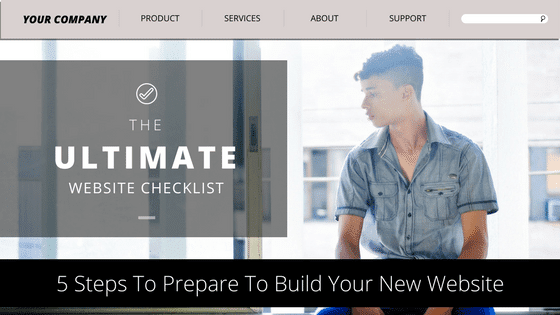Years ago, a small business website could be simple.
They were an online brochure responsible for providing information to potential clients.
Sites were simple, usually only containing a few pages.
However, as competition to show up first in the search results heated up, small business websites had to evolve.
It’s been a continuing process for years now.
But has yours kept up?
Contents
Outdated Websites Need To Catch Up
If your small business has a website that’s behind, you need to fix it.
Being unready for the modern web causes your company to slowly die off.
How can you tell if you’re behind, though?
I’ve got a few key ideas you need to pay attention to.
Decide if you relate to these and, if you do, consider fixing your web presence.
You Have No Website For Your Small Business
Ok, seriously, this is a no-brainer.
For a small business to exist today, they’ve got to exist on the web.
That means they need a social presence and a website.
It’s a non-negotiable.
You’d think that I wouldn’t need to mention this anymore, but a stunning 40% of small businesses don’t have a website still.
That’s insane.
Many of them still think that a website isn’t necessary.
But that’s not true.
There are a host of reasons why your small business needs a website.
Websites Are The Foundation Of Your Small Business’ Credibility.
Consumers expect you to have a web presence.
Without one, they’re far less likely to trust your brand.
Think about it from your own perspective.
When you come across a company that isn’t online, you have trouble trusting they’re real.
Something about having a website lends that instant confirmation that the company exists.
They feel more real.
If you want your small business to be credible, you need one too.
Websites Help Develop Your Small Business’ Brand
Branding is far more than a logo.
It’s the personality and life that your small business exudes.
Your brand is what comes to life for your customers and comes to mind when they think of your industry.
Done well, your brand will separate your small business from the rest.
A website is where your brand’s narrative takes place.
The design, layout, and content all help to illustrate what your brand is all about.
And it’s the best place to share your brand’s story.
People begin to connect with your brand through that story, making it a critical part of your marketing.
Websites Are At The Core Of Your Small Business’ Marketing
Billboard, radio, and even television advertisements aren’t the tools that small businesses can benefit from.
Most consumers are looking on the web for the products and services they need.
They’re going to find the companies whose websites can answer the questions they ask.
Great for companies with a website, but not helpful if you haven’t got one or if the one you have doesn’t have content.
SEO is the main path from consumers to your business.
For it to benefit you, you’ve got to have a website chocked full of great content.
By optimizing valuable, educational content, you’ll draw more visitors to your site and away from your competitors.
Websites Help Your Small Business Stay Competitive
Let’s face it, you can’t afford to lose clients to your competition.
I promise that someone you compete with locally has a website.
If you don’t, they’re getting found when you’re not.
You just can’t compete.
Prospective clients can feel that, too.
Because everyone wants to work with a winner, they tend to avoid the companies that don’t have a website or whose website is inferior.
A missing or lacking website equates a company with low-quality.
They figure that you don’t take your business seriously if you don’t invest in a website.
That means you lose control of how the public sees you.
Websites Allow You To Control The Perception Of Your Small Business
Your website is under your control.
That means you get to decide what’s reflected in your small business on it.
The website itself can also give you a ton of information about your prospects.
Information that gives you insight into what your audience thinks and how they behave.
Because websites make your audience easier to understand, they also make your audience easier to talk to.
Delivering your mission to your audience becomes as simple as it can be when you know how to explain it to them.
They’ll understand and connect with you better than ever.
With so much that a website can do, it’s easy to see why not having one is a clear indicator that you’re behind.
You’re Afraid To Send Clients Or Prospects To Your Site
Your small business website should be the hub for all your current and prospective clients.
Sending them there for information that confirms your expertise needs to be a part of your routine.
Never should you worry about there being the right information, either.
It should be a point of pride knowing that they can find everything they need there without trouble.
But is it that way with your small business website?
Many small business owners are hesitant to point people at their website.
And there are reasons that make sense.
If your website has issues, it could be a little embarrassing.
Your Small Business Website Has Outdated Information
One of the most common reasons small business websites become an embarrassment is the information they contain.
Industries often change, as do businesses.
Therefore, the information around them changes as well.
If your website was built several years ago, it may contain outdated information about either.
Needless to say, you’d prefer your client to not see you as outdated.
You want them to know your company is on the cutting edge of your industry.
A website that doesn’t reflect that doesn’t help you at all.
Your Small Business Website Is Ugly Or Dated
Have you been to some of the most popular websites lately?
There’s a certain standard they set that people subconsciously compare your site to.
It’s not intentional, but it’s happening.
You do it too, and that’s why it doesn’t feel so great to send people to your site.
The last time anyone updated your site was years ago.
Or at least it looks that way.
Maybe you tried to build it yourself.
And you had no idea what you were doing.
What you came up with doesn’t give you a whole lot of pride.
A well-built site should make you smile when you see it.
When you send people there, they should feel like they can trust you.
Your Small Business Website Often Draws Complaints
If something isn’t working right, people will let you know.
Consumers are often quick to dish out the complaints.
Often much quicker than they are with compliments.
After several complaints from people who’ve visited your website, you might not want to keep sending people to it.
The complaints could vary wildly.
Some say your site doesn’t have the information they need.
Others suggest it’s difficult to use.
Still, others tell you something broke or didn’t work correctly.
There are only so many ways people can tell you your website sucks before it starts to bother you.
Visitors to your website shouldn’t complain about using it.
When they start, it’s time for a change.
You Can’t Access Your Small Business Website On Mobile Devices
Look around you.
If you’re in public, you’ll see that most people are using their phones.
Many are checking email while others are on social networks.
But at some point, all of them will visit a website.
Yes, from their phone.
Mobile devices are becoming the primary access point to the internet for many people.
While there are still a lot of people that can’t afford computers, most people have some sort of smartphone.
They’re available at price points down to $20.
Chances are you’re looking for the customers who can afford something a little nicer.
Those consumers have more to spend on your products.
Either way, you need to make sure they can get to you and what you have to offer on their phone.
However, your small business website is inaccessible.
Your Small Business Website Loads Slowly
One of the biggest killers to a mobile website experience is a slow loading site.
Large images, code-intensive pages, and video content can make loading a website over a cell network incredibly frustrating.
Plus, it eats data, which makes mobile visitors unhappy.
When a site takes longer than 3 seconds to load, people leave.
They don’t like waiting to find the information.
There’s an expectation of instant results on the internet.
Especially in a world where major sites tend to load in a second or less.
And, as people so often complain about, the Millennial generation is interested in instant gratification.
If you want your site to help you successfully, it has to load fast on every device.
Your Small Business Website Isn’t Designed To Fit A Mobile Screen
You may have heard of a website design principle called responsive design.
It’s a website layout philosophy that suggests a site should adapt to the device it’s on, responding to the screen size accordingly.
There’s a complimentary philosophy called mobile-first design.
In this philosophy, the site is developed for a mobile device, then expanded for larger screens.
Both ideas hinge on the idea that doing things on a mobile screen is significantly different than on larger, desktop devices.
Certain areas of a phone screen are difficult to interact with, requiring users to either utilize both hands or stretch their thumbs uncomfortably.
Small business websites developed with these philosophies tend to have mobile versions that don’t keep important interactions in the top corners of the site.
Cornerstone interactions happen in the space of the phone screen that is easiest for everyone to reach.
So, what happens when people visit your site on a mobile device?
Chances are it either looks like a tiny version of the desktop site or it has important interactions in the top-left corner.
Don’t worry. You’re not alone.
However, if you want to survive, you’ll want to fix it.
Your Small Business Website Doesn’t Adapt To Fat Thumbs
User experience can decide a lot about a website.
If your audience can’t use your site, they won’t.
They’ll go somewhere else.
And they’ll voice their complaint.
On mobile devices, your audience needs to be capable of navigating with their thumbs.
The best option is to make sure your touchpoints aren’t too close together or too small.
When your audience wants to tap a link or button, they shouldn’t wind up somewhere they didn’t want to.
Your site’s swipe controls should never take precedence over their ability to swipe down the site.
Most of all, those with large thumbs (like myself) should never have trouble navigating your small business website on their phone.
You Can’t Get People To Stay On The Website Very Long
There’s a goal for every person who visits your site.
You want them to act on a certain feature and achieve a certain outcome.
But, for reasons you can’t ascertain, they’re leaving before they do.
Ideally, this wouldn’t be the case.
However, because something is going wrong, you’re losing visitors instead of converting them.
This is bad news.
Your Small Business Website’s Information Should Be Easy To Find
When your website is losing visitors, it’s likely because they can’t find what they’re looking for.
Most people aren’t visiting a website just to see what it looks like.
There’s a question they want an answer to.
They’re hoping to find it on your website.
If they can’t, they’ll move somewhere they can.
Usually, when you think your website has the answers, they’re hard to find.
Rather than including them in obvious or easy-to-find spots, they’re hidden behind convoluted navigation or confusing titles.
Often, they’re written in complicated formats.
You might feel the information is all simple to understand and easy to find, but it might not be for someone who has never visited before.
Consider it from the perspective of someone who is ignorant about your site and your industry.
That’s the realization that your website is behind.
Your Small Business Website’s Interface Should Work Simply
Websites need to be clear for your audience to use.
They shouldn’t find surprises or have difficulty getting to the content they want.
Navigation should be clear, content should be organized in a simple way, and there should be obvious calls-to-action that tell the visitor what to do next.
Similarly, everything should function smoothly on your site.
Contact forms should successfully contact you.
Links should direct where they’re supposed to instead of bringing on a 404 error.
None of your content should still be built in Adobe Flash.
When your website isn’t working properly, people get frustrated and leave.
It’s very simple.
Nobody likes to fuss with a website that doesn’t do what it’s supposed to.
Your Small Business Website’s Text Should Be Easy To Read
Ever visit a site that you couldn’t browse for too long?
Maybe it had you squinting or gave you a headache, but you weren’t sure why.
Typically, those reactions are caused by a problem with the text.
When the text is too small, people have a hard time reading it.
Just like anything else, your website needs a font size that’s large enough to make reading easy.
The standard is 16pt font, but many sites are making their text larger to improve readability.
Text contrast matters, too.
An incorrect contrast level or clashing colors makes your site’s text difficult on the eyes, causing headaches for your small business website visitors.
Use a basic, mild contrast, like dark grey over white.
It helps to keep everything easy to intake.
Bad font choices and too little white space can also make your content difficult to read.
Be certain the font is crystal clear and there’s enough space around the words to help keep the site content uncluttered.
When your audience can read, use, and find everything on your small business website easily, they’ll stick around.
You Know If Your Small Business Website Needs To Be Rebuilt
If your small business website has you feeling or relating to any of these things, it’s time to rebuild.
You can’t continue to survive with a website that doesn’t support you in the modern world.
Be honest with yourself and your business and you’ll know what to do.
When it’s time to rebuild, do it.
Don’t wait.





